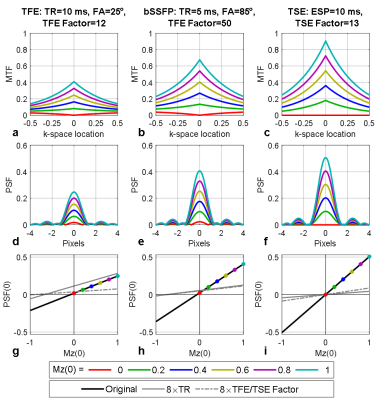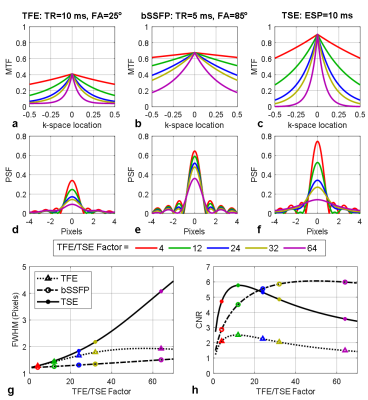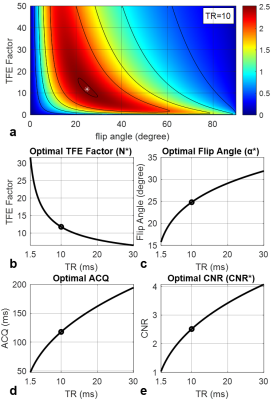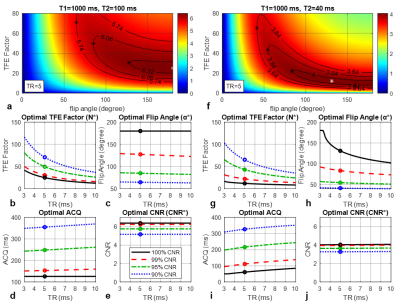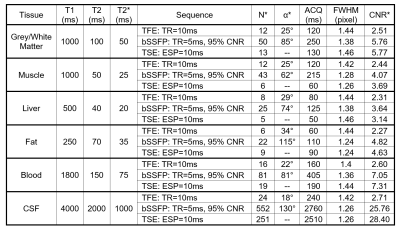4198
Analytical Characterization and Comparison of Magnetization-Relaxation-Induced Point Spread Functions of TFE, bSSFP and TSE Acquisitions1Department of Biomedical Engineering, Johns Hopkins University, Baltimore, MD, United States, 2The Division of MR Research, Department of Radiology, Johns Hopkins University, Baltimore, MD, United States, 3F.M. Kirby Research Center for Functional Brain Imaging, Kennedy Krieger Institute, Baltimore, MD, United States
Synopsis
Fast image acquisition is commonly used in quantitative MRI after contrast preparation, such as turbo-filed-echo (TFE), balance steady-state-free-precession (bSSFP), and turbo-spin-echo (TSE). k-Space data acquired are filtered by a modulation transfer function (MTF), causing contrast loss and blurring. Here, we derived the analytical formulation of the corresponding point spread function (PSF) of Cartesian TFE, bSSFP and TSE with 180° refocusing. The contrast-to-noise ratio (CNR) is defined and maximized, providing an analytically optimized selection of TFE/TSE factors and flip angles. bSSFP serves high CNR, small FWHM and large TFE factors. Long TR and short TE are suggested for TFE studies.
Introduction
Many advanced pulse sequences combine contrast-preparation modules, like T1, T2, diffusion or perfusion weighting, with an efficient acquisition scheme for high resolution, large spatial coverage, or both. This requires a low-high profile order to ensure the k-space center be acquired at the beginning of the readout to preserve the prepared contrast. A long readout to fill the rest of the k-space would be desired for speedy acquisition. Typical fast imaging methods include turbo-filed-echo (TFE), 1 balance steady-state-free-precession (bSSFP) 2 and turbo-spin-echo (TSE). 3 k-Space data are filtered by a modulation transfer function (MTF) due to magnetization relaxation during the acquisition, which may cause signal/contrast loss and blurring, 4,5 and is studied limitedly using the image-space point spread functions (PSF). 5,6 For TSE with 180° refocusing, T2 relaxation is the main effect for PSF; 5 For TFE and bSSFP, analytical characterization of relaxation-induced PSF has not been studied, as multiple factors (T1/T2, flip angle and TR) interact together. Here, we derived the analytical formulations of the MTF and PSF for Cartesian TFE, bSSFP for the first time, which are compared to TSE. The contrast-to-noise ratio (CNR) is defined and maximized with optimal TFE/TSE factor (N), flip angles (FA, α).Theory
TFEThe transient-state transverse signal after the $$$n^{th}$$$ excitation pulse is: $$M_{xy}(n)=A\varepsilon^{n-1}+B,$$$$A=M_z(0)E_2\sin\alpha-B,\quad B=\frac{M^0(1-E_1)}{1-\varepsilon}E_2\sin\alpha.$$ Here, $$$\varepsilon=e^{-TR/T1}\cos\alpha$$$, $$$M_z(0)$$$ is the initial longitudinal signal, $$$E_1=e^{-TR/T1}$$$, $$$ E_2=e^{-TE/T2^*}$$$ and $$$M^0$$$ is the equilibrium signal.
MTF at k-space location $$$k\in[-0.5, 0.5]$$$ with a low-high profile order in a single phase encoding direction is: $$MTF(k)=M_{xy}(2|k|N)=A\varepsilon^{2|k|N}+B.$$The corresponding PSF in the image domain is: $$PSF(x)=A\frac{\varepsilon^N(N\ln\varepsilon\cos(\pi x)+\pi x\sin(\pi x))-N\ln\varepsilon}{N^2\ln^2\varepsilon+\pi^2x^2}+B\ \text{sinc}(\pi x).$$The peak amplitude is a linear function of $$$M_z(0)$$$: $$PSF(0)=\frac{A(\varepsilon^N-1)}{N\ln\varepsilon}+B=\text{Slope}\ M_z(0)+\text{Intercept},$$ $$\text{Slope}=\frac{\varepsilon^N-1}{N\ln\varepsilon}E_2\sin\alpha,\quad\text{Intercept}=(1-\frac{\varepsilon^N-1}{N\ln\varepsilon})B.$$Based on this linearity, we define the CNR as the slope multiplied by an offset of SNR gain from an extended acquisition window ($$$ACQ=NTR$$$), which is proportional to $$$\sqrt{ACQ}$$$: $$CNR_{TFE}=\text{Slope}\sqrt{NTR}=\frac{\varepsilon^N-1}{\ln\varepsilon}\sqrt{\frac{TR}N}E_2\sin\alpha.$$Theoretically, $$$CNR_{TFE}$$$ is monotonically increasing with TR. For a fixed TR, there is an optimal solution: $$N^*=\frac{1.26}{\tau-0.5\ln{q(\tau)}},\quad \alpha^*=\arccos\sqrt{q(\tau)},\quad CNR_{TFE}^*=0.64\sqrt\frac{TR(1-q(\tau))}{\tau-0.5\ln{q(\tau)}}E_2.$$Here $$$\tau=\frac{TR}{T1}$$$, and $$$q(\tau)\in(0, 1)$$$ is a solution of the transcendental equation $$$-q\ln q+(1+2\tau)q-1=0$$$.
bSSFP
For bSSFP, the MTF assuming TE=TR/2 is: $$MTF(k)=A\lambda^{2|k|N}+B.$$$$A=M_z(0)\sin\frac{\alpha}2-B,\quad B=\frac{M^0\sqrt{E_2}(1-E_1)\sin\alpha}{1-(E_1-E_2)\cos\alpha-E_1E_2}.$$Here $$$\lambda=E_2\sin^2(\frac{\alpha}2)+E_1\cos^2(\frac{\alpha}2)$$$, and note that $$$E_2=e^{TR/T2}$$$ in bSSFP. 7
The corresponding PSF is: $$PSF(x)=A\frac{\lambda^N(N\ln\lambda\cos(\pi x)+\pi x\sin(\pi x))-N\ln\lambda}{N^2\ln^2\lambda+\pi^2x^2}+B\ \text{sinc}(\pi x).$$The peak amplitude is also a linear function of $$$M_z(0)$$$: $$PSF(0)=\frac{A(\lambda^N-1)}{N\ln\lambda}+B=\text{Slope}\ M_z(0)+\text{Intercept},$$ $$\text{Slope}=\frac{\lambda^N-1}{N\ln\lambda}\sin\frac{\alpha}2,\quad\text{Intercept}=(1-\frac{\lambda^N-1}{N\ln\lambda})B.$$The CNR of bSSFP is monotonically increasing with TR and there is an optimal solution for each TR:$$CNR_{bSSFP}=\frac{\lambda^N-1}{\ln\lambda}\sqrt{\frac{TR}N}\sin\frac{\alpha}2.$$$$N^*=\frac{1.26}{\ln m},\quad \alpha^*=\arccos\frac{2m-E_1-E_2}{E_1-E_2},\quad CNR_{bSSFP}^*=0.64\sqrt\frac{TR(E1-m)}{-(E_1-E_2)\ln m}.$$Here $$$m=max\{q(E_1),E_2\}$$$, and $$$q(E_1)$$$ is a solution of the transcendental equation $$$-q\ln q+q-E_1=0$$$.
When $$$T1<\frac{-TR}{-TR/T2+\ln{(1+TR/T2)}}$$$, $$$\alpha^*=180^{\circ}$$$. In this case, a smaller FA can be chosen with some CNR sacrifice characterized by the factor $$$\eta$$$: $$N_{\eta}^*=\frac{1.26\eta^2T2}{xTR},\quad \alpha_{\eta}^*=2\arccos\sqrt x,\quad CNR_{\eta,bSSFP}^*=\eta CNR_{bSSFP}^*.$$Here $$$x$$$ is the solution of the transcendental equation $$$\frac{x\ln E_2}{\ln{(E_2x+E_1-E_1x)}}=\eta^2$$$.
TSE
This work focuses on TSE with only 180° refocusing pulses. The MTF is: 5$$MTF(k)=M_z(0)E_2e^{2|k|r}.$$Here $$$ E_2=e^{-ESP/T2}$$$ and $$$ r=\frac{ESP\times N}{T2}$$$, where ESP is the echo spacing.
The PSF is: 5$$PSF(x)=M_z(0)E_2\frac{e^{-r}(\pi x\sin(\pi x)-r\cos(\pi x))+r}{r^2+\pi^2x^2}.$$The peak amplitude is proportional to $$$M_z(0)$$$: $$PSF(0)=\frac{1-e^{-r}}rE_2M_z(0).$$The CNR is: $$CNR_{TSE}=(1-e^{-r})E_2\sqrt\frac{T2}r.$$It is maximized ($$$=0.64E_2\sqrt{T2}$$$) when $$$r=1.26$$$. 5 The optimal CNR will decay monotonically with longer ESP.
Methods
Transcendental equations are solved numerically in MATLAB (Mathworks Inc.). An example is studied with T1=1000ms, T2=100ms and T2*=50ms. We chose some typical sequences in this example: TFE (TR/TE=10/1.5ms), bSSFP (TR/TE=5/2.5ms) and TSE (ESP=10ms). The optimal choice of some other typical pairs of T1 (250-4000ms) and T2 (40-2000ms) values are also given.Results
Figures 1 demonstrates the MTF (top) and PSF (middle) of variant Mz(0), and the linearity of peak-amplitude and Mz(0) (bottom) of typical TFE, bSSFP and TSE sequences. TFE has the largest peak-amplitude loss and large intercept (bias) increase when TR is 8× prolonged. The peak-amplitude loss of TSE is minimum.Figure 2 demonstrates the MTF (top) and PSF (middle) of different TFE/TSE factors, and corresponding FWHM and CNR (bottom). FWHM of TFE (1.2-2pixels) and bSSFP (1.2-1.6pixels) are increased slower than TSE (1.2-4.5pixels). CNR* of bSSFP and TSE are similar (~6). Compared to TSE (N*=~13), bSSFP achieves this optimal CNR with a much larger TFE factor (N*=~50).
Figure 3a shows a concave CNR map of the TFE sequence at TR=10ms as a function of FA and TFE factor. The maximum CNR (2.51) found at N*/α*=12/25° meets the analytical solution. Figures 3b-3e shows monotonically decreasing N* and increasing α*, ACQ, and CNR*TFE as TR increases.
Figures 4a-4e and Figures 4f-4j demonstrate CNR maps and N*,α*, ACQ and CNR*bSSFP with two different T1/T2 values. When T1=1000ms and T2=100ms, $$$T1<\frac{-TR}{-TR/T2+\ln{(1+TR/T2)}}$$$ and the optimal 100%, 99%, 95% and 90% CNR with α*/N*=180°/25, 128°/31, 85°/50 and 64°/71, meet the analytical solution. For all 3ms≤TR≤10ms, small CNR sacrifice (1%-10%) lead to a large decrease in FA (52°-116°) and increases in TFE Factor and ACQ.
Table 1 provides the analytical solutions of N*, α*, ACQ, FWHM and CNR* of the selected TFE, bSSFP and TSE sequences with some typical T1/T2/ T2* values.
Discussion and Conclusion
This work provides guidance to choose TFE, bSSFP and TSE parameters based on analytical formulation, which is also a useful tool to analyze and compare signal loss and blurring effects. Considering CNR and FWHM, bSSFP is especially suitable for large TFE factors. Long TR and short TE are suggested for TFE, suitable for spiral acquisitions.Acknowledgements
No acknowledgement found.References
1. Haase, A. “Snapshot flash mri. applications to t1, t2, and chemical-shift imaging,” Magnetic Resonance in Medicine, V. 13, No. 1, 1990, pp. 77–89.
2. Oppelt, A., Graumann, R., Barfuss, H., et al. “FISP—a new fast MRI sequence,” Electromedica, V. 54, No. 1, 1986, pp. 15–8.
3. Hennig, J., Nauerth, A., and Friedburg, H. “RARE imaging: A fast imaging method for clinical MR,” Magnetic Resonance in Medicine, V. 3, No. 6, 1986, pp. 823–33.
4. Constable, R. T., and Gore, J. C. “The Loss of Small Objects in Variable TE Imaging: Implications for FSE, RARE, and EPI,” Magnetic Resonance in Medicine, V. 28, No. 1, 1992, pp. 9–24.
5. Qin, Q. “Point spread functions of the T2 decay in k-space trajectories with long echo train,” Magnetic Resonance Imaging, V. 30, No. 8, 2012, pp. 1134–42.
6. Rahmer, J., Börnert, P., Groen, J., et al. “Three-dimensional radial ultrashort echo-time imaging withT2 adapted sampling,” Magnetic Resonance in Medicine, V. 55, No. 5, 2006, pp. 1075–82.
7. Scheffler, K. “On the transient phase of balanced SSFP sequences,” Magnetic Resonance in Medicine, V. 49, No. 4, 2003, pp. 781–3.
Figures
